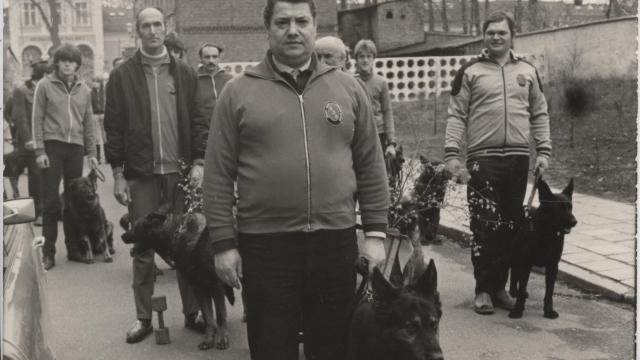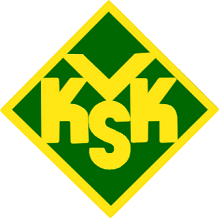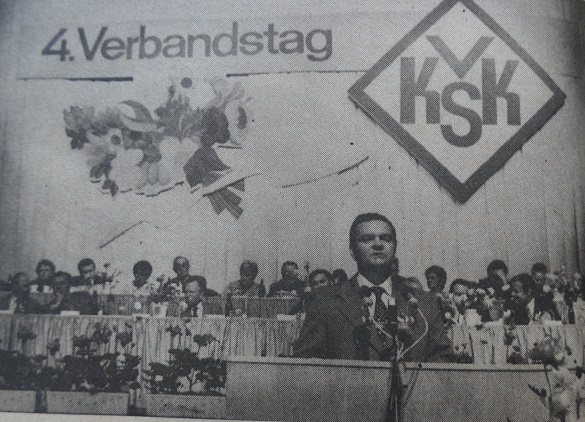History of the pedigree dogs from 1945-1990 in the GDR
GDR history
With special consideration of Schnauzers and Pinschers in the GDR Here is how to navigate through this website:
GDR history
1. The socialist dog
2. Organization of pedigree dog breeding and dog sports in the GDR
Association of Mutual Farmers’ Aid (VdgB)
Association of Allotment Gardeners, Settlers and Small Animal Breeders (VKSK) Society for Sport and Technology (GST)
Service and Working Dogs Section (SDG)
3. The offspring assessment and the Wermeß-number system in the GDR
4. The dog – specialist journal of the GDR
5. Special Breeding Association (SZG) Schnauzer and Pinscher
6th Special Breeding Association (SZG) Giant Schnauzer
7. The GDR and its abbreviations
GDR history
1. The socialist dog
In the socialist countries, and thus also in the GDR, people and animals grew
valued according to the utility ethos. The central question was: “What contribution was made to the construction of socialism?” The (pedigree) dog also had to submit to this question. This is how hunting, guard and herding hunde accepted in the GDR, while luxury dogs (without special task), lap dogs or even strays made no contribution to the construction of socialism. Breeding for performance was therefore more important than breeding for beauty. Service and utility dogs clearly preferred. At the major exhibitions in the GDR were German shepherds, Rottweilers, Dobermans and hounds clearly over-represented. For hunting dogs were special organized exhibitions.

GDR history
Dog athletes in the GDR
Performance tests were of great importance. The pedigree dog breed had no more alone the implementation of the respective standard as a goal; far more important was the ability of the pedigree dog to certain achievements. In the East were powerful, hardy working dogs asked. The dog was here — like the “workers” — as a working pet “a servant in building socialism”. On the other hand, dogs that are not used as service, working, herding or hunting dogs could, until the beginning of the 1960s, only as a food competitors and potential disease carriers seen.
Precious foods, in particular Wasting meat on “non-working” and not “edible” animals was for the GDR, the had major food supply problems for meat and animal products until 1963, an incredible luxury.
In the early years of the GDR, service and utility dog breeds were also more popular than the so-called luxury and lap dogs. Absolute number 1 was the German shepherd, who was bred with a focus on performance as a service dog. However, the popularity of the so-called luxury dogs or “useless” dogs decreased 1970s among the population of the GDR. The breeding and keeping of these dogs was
More and more popular.
The GDR leadership could no longer ignore this development and ultimately legitimized this dog ownership and explained the greatly increased willingness owning a dog is now seen as a “manifestation of social progress in the DDR”. Here, too, keeping a dog had to have a function; in this case, an educational one Function. According to the GDR leadership, keeping pets and dogs contributes to development the “socialist personality” of man, because there will be responsibility,
compliance with duties and learning discipline, perseverance and consistency.
The dog thus promoted the “socialist incarnation”.
GDR history
The claim of the GDR leadership the entire social development in all their Aspects to plan and control also referred to the dog being. The dog had to To be “useful” in the sense of socialism. There was a real compulsion to hold of dogs to find a reason. The reasons for owning a dog were the contribution to
socialist personality development, the recovery effect to strengthen the working performance of the worker, the security aspect (service dogs in the NVA, police and border protection) and the economic benefit (export of dogs to obtain foreign currency).
However, keeping the dog had to be regulated and controllable. Stray dogs were disposed of in animal shelters and here — there useless — relatively quickly killed. Dog owners — particularly dog handlers — have been turned into the controllable centralized organizational structures to better control them and im to be able to educate socialist sense. All club structures previously were dissolved and incorporated into mass organizations because clubs promote a bourgeois individualism and are reservoirs of reactionary forces.
However, breeding suffered from the politically driven isolation, so that no “fresh” blood came into breeding. Only at the end of the 1980s – and only with a special permit – an exchange with breeders in Poland, the Czech Republic and Hungary is possible. You could export pedigree dogs, on the other hand, go very well to western Europe because of the procurement of foreign currency. The supply of pet food was a major problem in the GDR in the 1970s and 1980s.
Ready-to-eat and canned dog food has been around since the 1970s, but was rarely sold have. The quality was inferior and many GDR citizens didn’t even know that these feeds could be bought, they were so rarely offered. The pet owners of the GDR were in the care of the dogs on “homemade” or informal networks reliant. A lot had to be improvised or made by hand. Was fed to the largest Portion meat, oatmeal, and vegetables, and what was left over from your own meals.
2. Organization of pedigree dog breeding and dog sports in the GDR.
Association of Mutual Farmers’ Aid (VdgB)
From the commissions for land reform formed since autumn 1945 and committees of the
mutual farmer’s aid, was at the First German Farmers’ Day in Berlin (East) in
November 1947 the Central Association of Mutual Farmers’ Aid was founded. In November 1950, under pressure from the SED, this merged with the Central Association of Rural economic cooperatives in Germany to unite mutual farmer help / farm trade cooperatives (VdgB/BHG) together. After 1957 the Organization only “Association of Mutual Farmers’ Aid”, or abbreviated “VdgB”, called.
The aim of the organization VdgB was first the land reform and later the construction of a
to support socialist agriculture. In the Canine Department in the Central Association of Small Animal Breeders — a department of the VdgB– the formerly independent pedigree dog clubs were organized.
From the point of view of dog breeders and athletes, the VdgB was still the most pleasant umbrella organization, because the VdgB did not interfere in the breeding and technical concerns of the
ties of the respective dog breeds. It has not yet been tried, the breeders and To educate dog athletes to the socialist idea.

Meeting of the VdgB mass organization
The specialist associations of the respective dog breeds could continue to create their own stud book and had its own office.
The Technical Committee for Canines wrote in a circular in 1950 Initiated by the competent authorities it is up to the pedigree dog breeding clubs to set up an independent stud book and to protect dates for performance tests and shows and to pronounce
The specialist associations eventually became special breeding communities (SZG), which depend on race were named as follows: “Special breeding community German shepherds in the association of mutual Farmers’ Aid (BHG) Central Association”
During this time, many SZG gave their own newsletter about their respective dog breed out. However, these sheets had to be discontinued soon because the SZG the necessary paper quota has not been allocated, so that the fonts are no longer- could be provided. However, such self-responsible writings were also used by the Officials of the service supervision authority of the VdgB do not like to be seen, so that the- sufficient paper quotas were not only due to the shortage of raw materials. The notification- sheets were published by the umbrella organization’s magazine “The Dog”, which appeared for all pedigree dogs from 1952, replaced.
While it is still in the early stages of a cooperation with the West German breeding and If a sports company was interested, an independent studbook was soon published. In 1948, the first exhibition was held again in the Eastern zone. Exhibitions and The shows had to be coordinated with the VdgB. The alienation or division between West and East began. in 1952 the SZG became a member of the Association of Allotment Gardeners, Settlers and Small Animal Breeders (VKSK) and later in 1959 the service and utility dogs of the company for Sports and Technology (GST). In the GST, all service and utility dogs were- combined races. Association of Allotment Gardeners, Settlers and Small Animal Breeders (VKSK)
 At the end of 1952, the Central Association of Allotment Gardeners, Settlers and Small Animal Breeders was founded with Based in Berlin. The organizations that existed until then, the “Small- gardening assistance of the FDGB” and the “Small animal breeding sector in the VdgB (BHG)”, went to the VKSK on. Already in 1953, the VKSK was dissolved again by the Central Committee of the SED, because it- there were differences in the organization of the association. The structure of the VKSK is limited to at the local and district level without an umbrella organization. The district associations of the VKSK became the subordinated to local councils and managed there as a legal entity. On April 22, 1959, the Central Committee approved the creation of the Central Association of the VKSK. The central Association of the VKSK was founded again on November 29, 1959 in Leipzig and ge- it was organized centrally as an independent organization. The association was divided into business and local groups, district associations and the central- association. In addition to the division of allotment gardeners, specialist divisions such as Rassegeflügel-, Rasse- rabbit, ornamental poultry, exotic and canary, fur-bearing animals, goat and dairy sheep-, Pedigree dogs and pedigree cats and beekeepers are connected.
At the end of 1952, the Central Association of Allotment Gardeners, Settlers and Small Animal Breeders was founded with Based in Berlin. The organizations that existed until then, the “Small- gardening assistance of the FDGB” and the “Small animal breeding sector in the VdgB (BHG)”, went to the VKSK on. Already in 1953, the VKSK was dissolved again by the Central Committee of the SED, because it- there were differences in the organization of the association. The structure of the VKSK is limited to at the local and district level without an umbrella organization. The district associations of the VKSK became the subordinated to local councils and managed there as a legal entity. On April 22, 1959, the Central Committee approved the creation of the Central Association of the VKSK. The central Association of the VKSK was founded again on November 29, 1959 in Leipzig and ge- it was organized centrally as an independent organization. The association was divided into business and local groups, district associations and the central- association. In addition to the division of allotment gardeners, specialist divisions such as Rassegeflügel-, Rasse- rabbit, ornamental poultry, exotic and canary, fur-bearing animals, goat and dairy sheep-, Pedigree dogs and pedigree cats and beekeepers are connected.
The centralization efforts of the entire breeding and training system became very from a critical point of view. The breed dog clubs feared a significant restriction of their previous self-employment and your rights to have a say in a mass organization such as the VKSK with its numerous topics, for which the breed dog clubs are more of a- it was an orderly topic. It was therefore agreed to use the VKSK as an umbrella organization to- but also to point out that the special breeding communities, as the successors of the Pedigree dog clubs, continue to exist with the right to independently manage their studbooks to be allowed to lead. Therefore, the following declaration of consent was given for integration into the VKSK: “The cynologists of the GDR predict the formation of a new mass organization under the- to ensure that the breeding and organizational matters are handled by the special breeding- communities are absolutely guaranteed.”
On 22.04.1954, the Council of Ministers of the GDR voted by decree on the establishment and tasks of the VKSK too. This was evaluated as follows (Der Hund 6/1954): “Above all, the Regulation recognises that the previously existing cer- fragmentation in the field of allotment gardening and settlement and small animal breeding in the German Democratic Republic as a past evil is eliminated. Great is the contrast to the West of our association, where the organizations the allotment gardener and small animal breeder lives a life in hundreds of associations and groups to pass out and not receive any support from the Bonn state. That is why they are also hardly capable of achievements.” The centralization and synchronization in central organizational structures of the GDR- however, the systematic synchronisation during the regime of the National- socialists. The reasoning was identical.
The special breeding communities were recognized similarly to the student councils under National Socialism, but the independence and Rights were more and more restricted in the following. In 1955, the finances, inventory and material as well as studbooks of the SZG Schnauzer were- Pinscher confiscated. The still existing clubs and dog clubs were centralized. As a mass organization of the GDR, the association had the following tasks: 1. Control function: control and steering of the population 2. Transmission function: Population for the goals of the SED (Socialist Unity Party Germany) mobilize and activate 3. Representation of interests 4. Identification function: educating the population to conformity 5. Formation of cadres: training and implementation of state-loyal officials in the organization The VKSK was organized into divisions. The divisions were combined into county and district associations- nutshell. The highest organ of the VKSK was the Association Day.
The abolition of the organization as an association according to Western patterns was an essential step for the education of people in the GDR (Der Hund 7/1966): “The overcoming of the former club-like thinking is not only manifested in a more active Participation in the life of the association itself, but mainly in an open-minded participation the political events of our time. This is especially true in the annual- collections of the divisions are reflected. These were no longer closed events like they used to be, but many representatives of the National Front and local state bodies took part in them with which the members discussed which measures should be taken in the municipalities and cities in To make our socialist life even richer and more beautiful.” How nice the participation of local state bodies really was remains to be seen….
The management of the special breeding associations was effectively disenfranchised. Only the professional Work remained with the management of the SZG; the influence on organizational or member issues accounted. The management of the SZG was forbidden to keep membership lists. Karl-Heinz Trautmann writes about this: “An ever more costly apparatus came to us with central authority to issue instructions. Each Application, every confirmation, every communication of a breeding nature went through the organizational path through the instances of the district and district management to the Central Board umd came on this way as a refusal or consent. 
An expense that we bear and accept financially must.” In the multi-year annual plans, the division of pedigree dog breeders also had to meet goals. in 1966 it was planned to increase the number of members by 5% annually until 1970, the breeding to improve and increase the export of pedigree dogs for the purpose of obtaining foreign currency.
Credit: wallenfels-pinscher Continue Reading Next Page GDR History 2
